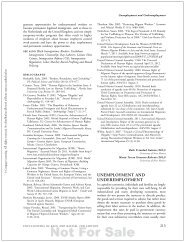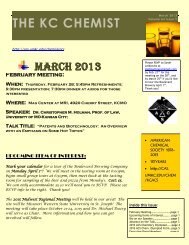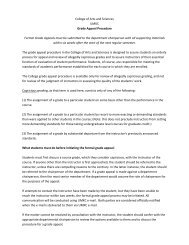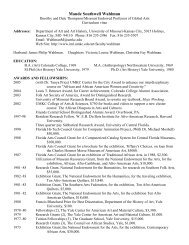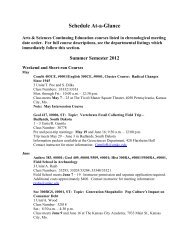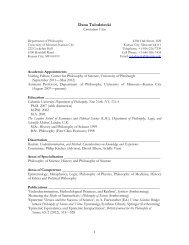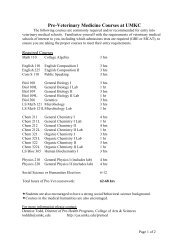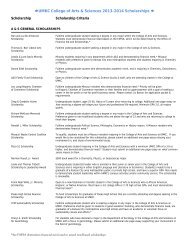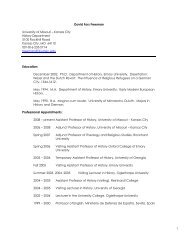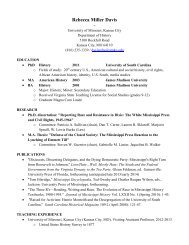Photofragmentation of the - American Chemical Society Publications
Photofragmentation of the - American Chemical Society Publications
Photofragmentation of the - American Chemical Society Publications
Create successful ePaper yourself
Turn your PDF publications into a flip-book with our unique Google optimized e-Paper software.
7284<br />
<strong>Phot<strong>of</strong>ragmentation</strong> <strong>of</strong> <strong>the</strong> closo-Carboranes Part II: VUV Assisted Dehydrogenation in <strong>the</strong><br />
closo-Carboranes and Semiconducting B10C2Hx Films<br />
Introduction<br />
Eckart Rühl, † Norman F. Riehs, † Swayambhu Behera, ‡,§ Justin Wilks, ‡ Jing Liu, |<br />
H.-W. Jochims, † Anthony N. Caruso, ⊥ Neil M. Boag, # Jeffry A. Kelber, ‡ and<br />
Peter A. Dowben* ,|<br />
Physikalische und Theoretische Chemie, Freie UniVersität Berlin, Takustr. 3, D-14195 Berlin, Germany,<br />
Departments <strong>of</strong> Chemistry and Physics and Center for Electronic Materials Processing and Integration,<br />
UniVersity <strong>of</strong> North Texas, Denton, Texas 76203, U.S.A., Department <strong>of</strong> Physics and Astronomy, Nebraska<br />
Center for Nanostructures and Materials, UniVersity <strong>of</strong> Nebraska-Lincoln, Lincoln, Nebraska 68588-0111,<br />
U.S.A., Department <strong>of</strong> Physics, UniVersity <strong>of</strong> Missouri-Kansas City, Kansas City, Missouri 64110, U.S.A., and<br />
Functional Materials, Institute for Materials Research, Cockcr<strong>of</strong>t Building, UniVersity <strong>of</strong> Salford,<br />
Salford M5 4WT, United Kingdom<br />
ReceiVed: April 27, 2010; ReVised Manuscript ReceiVed: June 3, 2010<br />
The dehydrogenation <strong>of</strong> semiconducting boron carbide (B10C2Hx) films as well as <strong>the</strong> three closo-carborane isomers<br />
<strong>of</strong> dicarbadodecaborane (C2B10H12) and two isomers <strong>of</strong> <strong>the</strong> corresponding closo-phosphacarborane (PCB10H11) all<br />
appear to be very similar. Photoionization mass spectrometry studies at near-threshold gas phase photoionization<br />
indicate that <strong>the</strong> preferred pathway for dissociation <strong>of</strong> <strong>the</strong> parent cation species (C2B10H10 + or PCB10H9 + ) is, in all<br />
cases, <strong>the</strong> loss <strong>of</strong> H2. Ab initio density functional <strong>the</strong>ory (DFT) calculations indicate that energetically preferred<br />
sites for exopolyhedral hydrogen (B-H) bond dissociation are in all cases at B atoms opposite <strong>the</strong> C atoms in <strong>the</strong><br />
parent cage molecule. The site <strong>of</strong> photodissociation <strong>of</strong> hydrogen from semiconducting boron carbide (B10C2Hx)<br />
films, fabricated by plasma-enhanced chemical vapor deposition, is a cage boron atom that can bond to nitrogen<br />
upon exposure to VUV light in <strong>the</strong> presence <strong>of</strong> NH3. Shifts in core level binding energies due to nitrogen bond<br />
formation indicate that B-N bond formation occurs only at B atoms bound to o<strong>the</strong>r boron atoms (B-B sites) and<br />
not at B-C sites or at C sites, in agreement with gas phase results.<br />
There has been a resurgence <strong>of</strong> interest in carborane<br />
chemistry. Although <strong>the</strong> discovery <strong>of</strong> closo-carboranes in 1963<br />
was followed quickly accompanied by a flurry <strong>of</strong> functionalization<br />
chemistry, 1 <strong>the</strong> resurgence <strong>of</strong> interest in closo-1,2dicarbadodecaborane<br />
(ortho-carborane) has been to some extent<br />
driven by its extensive use as a precursor source molecule for<br />
<strong>the</strong> fabrication <strong>of</strong> a semiconducting boron carbide, 2-11 a material<br />
suitable for <strong>the</strong> fabrication <strong>of</strong> solid state neutron detectors. 5-10,12<br />
The method <strong>of</strong> choice, at present, for making semiconducting<br />
boron carbide thin films is to use closo-1,2-dicarbadodecaborane<br />
(ortho-carborane), and its isomers, as a source gas(es) for<br />
radical-induced polymerization via plasma-enhanced chemical<br />
vapor deposition (PECVD). The resulting boron carbides, <strong>of</strong><br />
approximate stoichiometry “C2B10Hx” (where x represents up<br />
to 40 at% fraction <strong>of</strong> hydrogen 13 ), exhibit a range <strong>of</strong> electronic<br />
properties but are all semiconductors. The hydrogen content<br />
suggests that decomposition <strong>of</strong> <strong>the</strong> closo-carboranes, to form<br />
<strong>the</strong> C2B10Hx boron carbide semiconductor, does not result in<br />
complete fragmentation <strong>of</strong> <strong>the</strong> icosahedral cage. Despite <strong>the</strong><br />
determined 40 at% H concentration in carborane saturated<br />
plasma grown films, 13 some dehydrogenation must occur <strong>of</strong>f<br />
* To whom correspondence should be addressed. Phone: 402-472-9838.<br />
Fax: (402) 472-2879. E-mail: pdowben@unl.edu.<br />
† Freie Universität Berlin.<br />
‡ Department <strong>of</strong> Chemistry, University <strong>of</strong> North Texas.<br />
§ Department <strong>of</strong> Physics, University <strong>of</strong> North Texas.<br />
| University <strong>of</strong> Nebraska-Lincoln.<br />
⊥ University <strong>of</strong> Missouri-Kansas City.<br />
# University <strong>of</strong> Salford.<br />
J. Phys. Chem. A 2010, 114, 7284–7291<br />
10.1021/jp103805r © 2010 <strong>American</strong> <strong>Chemical</strong> <strong>Society</strong><br />
Published on Web 06/23/2010<br />
<strong>the</strong> icosahedral carborane cage during semiconducting boron<br />
carbide film growth as o<strong>the</strong>rwise <strong>the</strong> resulting semiconducting<br />
film would exhibit a much higher band gap 4,5,14-16 and would<br />
not form stable semiconductor devices to high temperatures, as<br />
is observed, 3 although densification is observed with some boron<br />
carbides, 17 presumably due to hydrogen loss. Knowledge <strong>of</strong> <strong>the</strong><br />
molecular decomposition and fragmentation <strong>of</strong> boron-containing<br />
cage molecules are <strong>of</strong> central importance to our understanding<br />
<strong>of</strong> <strong>the</strong> relationships between <strong>the</strong> PECVD process and resulting<br />
materials properties. The structures <strong>of</strong> <strong>the</strong> different semiconducting<br />
boron carbides, and <strong>the</strong> relationship between <strong>the</strong><br />
different polytypes, are not well understood at present, in spite<br />
<strong>of</strong> much successful device fabrication. Some studies <strong>of</strong> closocarborane<br />
decomposition have been undertaken 14,16,18,19 but have<br />
not investigated <strong>the</strong> favored dehydrogenation routes in both <strong>the</strong><br />
free closo-carboranes and <strong>the</strong> semiconducting boron carbide<br />
films grown from <strong>the</strong> closo-carboranes.<br />
In an effort to understand <strong>the</strong> radical-induced polymerization<br />
<strong>of</strong> <strong>the</strong> carboranes (i.e., semiconducting film growth), based on<br />
<strong>the</strong>ir partial dehydrogenation during plasma-enhanced chemical<br />
vapor deposition, we have investigated <strong>the</strong> cation dehydrogenation<br />
<strong>of</strong> <strong>the</strong> free closo-carborane and related phosphacarboranes.<br />
We present here <strong>the</strong> bond-specific photochemistry induced<br />
in a solid boron carbide film, as characterized by core level<br />
X-ray photoelectron spectroscopy (XPS) and find strong similarities<br />
with <strong>the</strong> observed dehydrogenation for <strong>the</strong> various<br />
isomers <strong>of</strong> closo-dicarbadodecaborane and closo-phosphacarbadodecaborane,<br />
schematically shown in Figure 1, investigated<br />
by photoionization mass spectrometry in <strong>the</strong> gas phase.<br />
The NH3 reaction with <strong>the</strong> semiconducting inorganic nonvolatile
<strong>Phot<strong>of</strong>ragmentation</strong> <strong>of</strong> <strong>the</strong> closo-Carboranes J. Phys. Chem. A, Vol. 114, No. 27, 2010 7285<br />
Figure 1. Schematic representations <strong>of</strong> <strong>the</strong> three different isomers <strong>of</strong> closo-dicarbadodecaborane: (a) ortho-carborane (1,2-C2B10H12), (b) metacarborane<br />
(1,7-C2B10H12), and (c) para-carborane (1,12-C2B10H12), and (d) ortho-1-phospha-2-carbadodecaborane (1,2-PCB10H11), and (e) meta-<br />
1-phospha-7-carbadodecaborane (1,7-PCB10H11).<br />
film allows insight into bond-breaking chemistry <strong>of</strong> semiconducting<br />
boron carbide, as <strong>the</strong> NH3 reaction at photoinduced<br />
radical sites would yield ei<strong>the</strong>r B(1s) or C(1s) chemical shifts<br />
observable by X-ray photoelectron spectroscopy (XPS).<br />
Experimental Methods<br />
7-Me3N-7-CB10H12 was prepared from decaborane 20 and<br />
converted first to 1,2-PCB10H11 and <strong>the</strong>n to 1,7-PCB10H11 by<br />
<strong>the</strong> methodology <strong>of</strong> Todd and Little. 21 The sublimed crystalline<br />
1,7-PCB10H11 was recrystallized from ethanol and resublimed<br />
at 48 °C (0.01 mmHg) in 45% yield. All <strong>the</strong> isomers <strong>of</strong><br />
C2B10H12, that is, ortho-carborane (closo-1,2-dicarbadodecaborane<br />
or 1,2-C2B10H12), meta-carborane (closo-1,7-dicarbadodecaborane<br />
or 1,7-C2B10H12), and para-carborane (closo-1,12dicarbadodecaborane<br />
or 1,12-C2B10H12), were purchased from<br />
ei<strong>the</strong>r Katchem or Aldrich and resublimed prior to use, with<br />
purity in all cases confirmed by NMR spectroscopy, as described<br />
elsewhere. 15<br />
The gas phase photoionization and photodecomposition <strong>of</strong><br />
<strong>the</strong> isomers <strong>of</strong> closo-dicarbadodecaborane and closo-phosphacarbadodecaborane<br />
(Figure 1) were investigated by photoionization<br />
mass spectrometry using synchrotron vacuum ultraviolet<br />
(VUV) radiation. Monochromatic light was provided by a3m<br />
normal incidence monochromator (3 m NIM-1), at BESSY II,<br />
which was equipped by a 600 L/mm grating. For higher fluences,<br />
undispersed VUV synchrotron radiation was used. Inserting a<br />
LiF cut<strong>of</strong>f filter allows us to measure mass spectra without<br />
higher order radiation or stray light. A quadrupole mass filter<br />
was used for photoion detection. 22<br />
Experimental studies <strong>of</strong> dehydrogenation and concomitant<br />
reactions with ammonia <strong>of</strong> <strong>the</strong> inorganic semiconducting boron<br />
carbide films were carried out in a two-chamber system<br />
consisting <strong>of</strong> an analysis chamber (base pressure 5 × 10 -10 Torr)<br />
with hemispherical analyzer and dual anode X-ray source, and<br />
an introduction/photochemistry chamber (base pressure 1 × 10 -7<br />
Torr). This system has been described previously in detail. 23<br />
The selective chemistry experiments were performed with<br />
irradiation from a sealed Xe lamp (hυ ) 8.4 eV), in <strong>the</strong> presence<br />
<strong>of</strong> 10 -4 Torr NH3. A MgF2 window sealed <strong>the</strong> atmosphere within<br />
<strong>the</strong> Xe line source lamp (Resonance Ltd.) from <strong>the</strong> rest <strong>of</strong> <strong>the</strong><br />
chamber. A photon flux <strong>of</strong> ∼10 15 cm -2 s -1 on <strong>the</strong> sample, with<br />
a photon energy <strong>of</strong> 8.4 eV, is estimated. The XPS spectra were<br />
acquired with <strong>the</strong> analyzer in constant pass energy mode (50<br />
eV) using Mg KR radiation at 300 W/15 keV. Standard<br />
Gaussian-Lorentzian line-shapes, corresponding to Voigt pr<strong>of</strong>iles,<br />
were used to simulate spectra for comparison with<br />
experiment.<br />
Boron carbide films ∼1 µm thick were formed by plasmaenhanced<br />
chemical vapor deposition (PECVD) on <strong>the</strong>rmally<br />
oxidized Si substrates using ortho-carborane as <strong>the</strong> source gas,<br />
as procedure described previously, 13 and subsequently characterized<br />
by ellipsometry and FTIR. Samples 1 cm ×1 cm were<br />
scribed from <strong>the</strong> substrate and mounted on a Ta sample holder.<br />
Sample temperature was monitored with a type K <strong>the</strong>rmocouple<br />
attached to <strong>the</strong> substrate. Following insertion into UHV, <strong>the</strong><br />
boron carbide samples were lightly Ar + sputtered with 1000<br />
eV Ar + to remove surface contamination.<br />
Free Molecular closo-Carborane Ionization Energies. As<br />
preliminary characterization, we measured and compared <strong>the</strong><br />
ionization energies <strong>of</strong> <strong>the</strong> three different isomers <strong>of</strong> closodicarbadodecaborane<br />
(ortho-carborane (1,2-C2B10H12), metacarborane<br />
(1,7-C2B10H12), para-carborane (1,12-C2B10H12)), and<br />
two related icosahedral cage molecules, 1-phospha-2-carbadodecaborane<br />
(1,2-PCB10H11) and 1-phospha-7-carbadodecaborane<br />
(1,7-PCB10H11). We determined <strong>the</strong> adiabatic ionization<br />
energy from <strong>the</strong> first onset <strong>of</strong> appearance <strong>of</strong> <strong>the</strong> parent ion mass<br />
peak, similar to previous work. 24,25 As illustrated in Figure 2,<br />
<strong>the</strong> parent ion signal for 1,7-PCB10H11 provides for <strong>the</strong> adiabatic<br />
ionization energy 10.10 ( 0.02 eV. In addition, <strong>the</strong> vertical<br />
ionization energy is derived from a linear extrapolation <strong>of</strong> <strong>the</strong><br />
ion signal, as indicated in Figure 2, yielding 10.22 ( 0.03 eV.<br />
The vertical ionization energy <strong>of</strong> closo-1,2-C2B10H12 derived<br />
in this manner, yielding IE ) 10.17 ( 0.05 eV. This is in good<br />
agreement with prior photoionization values <strong>of</strong> 10.13 eV 26 and<br />
10.1 ( 0.2, 27 although significantly smaller than <strong>the</strong> photoelectron<br />
value <strong>of</strong> 10.62 eV. 28 Similarly, our value for <strong>the</strong> vertical
7286 J. Phys. Chem. A, Vol. 114, No. 27, 2010 Rühletal.<br />
Figure 2. The parent ion current for <strong>the</strong> closo-phosphacarborane 1,7<br />
PCB10H11, as a function <strong>of</strong> photon energy. Higher order light (Ephoton ><br />
11.9 eV) has been suppressed with a LiF window. The inset is <strong>the</strong><br />
doubly differential parent ion current as a function <strong>of</strong> photon energy<br />
for <strong>the</strong> same molecule to illustrate <strong>the</strong> vertical parent molecule ionization<br />
energy. The vertical ionization energy lies at about 10.22 eV.<br />
ionization energy <strong>of</strong> closo-1,7-C2B10H12, IE) 10.23 ( 0.05<br />
eV, is in good agreement with prior values obtained from<br />
photoionization (10.14 eV, 26 10.1 ( 0.2 27 ) and photoelectron<br />
spectroscopy (10.1. eV, 28 10.19 eV, 29 and 10.78 ( 0.05 28 ). Not<br />
too surprisingly, <strong>the</strong> highly symmetric closo-1,12-C2B10H12 has<br />
a slightly higher vertical ionization energy <strong>of</strong> IE ) 10.42 (<br />
0.05 eV in our studies, again in general agreement with <strong>the</strong><br />
prior photoionization value <strong>of</strong> 10.3 ( 0.2 eV 27 and <strong>the</strong> prior<br />
photoelectron spectroscopy result <strong>of</strong> 10.6 eV. 30 These experimental<br />
photoionization yield values for <strong>the</strong> ionization energy<br />
<strong>of</strong> <strong>the</strong> three closo-carboranes (C2B10H12) isomers are only<br />
slightly higher than those energetic values calculated by density<br />
function <strong>the</strong>ory 9.95 to 10.12 eV, 18 so overall <strong>the</strong> agreement<br />
with expectations is excellent. As such, this is a good test <strong>of</strong><br />
<strong>the</strong> effectiveness <strong>of</strong> hybrid density function <strong>the</strong>ory (DFT-<br />
B3LYP), using standard 6-31 G* basis set and <strong>the</strong> Perdew-Wang<br />
91 exchange correlation potential, used below (vide infra) and<br />
elsewhere to model <strong>the</strong> favored fragmentation energetics <strong>of</strong> <strong>the</strong><br />
closo-carboranes. 15,18,31 We can estimate <strong>the</strong> error in <strong>the</strong><br />
calculated energetics to be about 3% for <strong>the</strong>se systems, and <strong>the</strong>se<br />
errors are largely systematic.<br />
The first vertical ionization energies (IE) have now been<br />
determined for <strong>the</strong> first time for two closo-phosphacarboranes:<br />
ortho-1,2-PCB10H11,IE) 10.17 ( 0.05 eV (adiabatic ionization<br />
energy: 10.00 ( 0.05 eV), and meta-1,7-PCB10H11, IE) 10.23<br />
( 0.05 eV (adiabatic ionization energy: 10.10 ( 0.02 eV).<br />
It is above <strong>the</strong>se ionization threshold that cation fragmentation<br />
occurs, and although multiple fragmentation routes are possible<br />
for <strong>the</strong> closo-carboranes, 18,19 <strong>of</strong> interest here are <strong>the</strong> hydrogen<br />
loss from <strong>the</strong> parent cation as occurs at energies near <strong>the</strong><br />
ionization energies. 18<br />
closo-Carborane Dehydrogenation in <strong>the</strong> near VUV.<br />
Because <strong>of</strong> <strong>the</strong> limited count rates, total flux was important for<br />
obtaining photoionization mass spectra at sufficient ion intensity.<br />
Photoionization mass spectra were taken in <strong>the</strong> range <strong>of</strong><br />
126-146 amu with zero-order light from <strong>the</strong> normal incidence<br />
monochromator. The geometry <strong>of</strong> <strong>the</strong> normal incidence monochromator<br />
cuts <strong>of</strong>f <strong>the</strong> zero order synchrotron light at above<br />
about 35 eV. On <strong>the</strong> o<strong>the</strong>r hand, phot<strong>of</strong>ragmentation <strong>of</strong> <strong>the</strong><br />
closo-carborane cation should occur at photon energies above<br />
<strong>the</strong> photoionization thresholds, 18 just discussed. It is at <strong>the</strong>se<br />
low energies <strong>of</strong> 10-35 eV that dehydrogenation is believed to<br />
dominate <strong>the</strong> fragmentation process. 18<br />
Because <strong>of</strong> <strong>the</strong> multiplicity <strong>of</strong> boron atoms (10), even just<br />
<strong>the</strong> relative abundance <strong>of</strong> 10 B (19.8%) and 11 B (80.2%), will<br />
Figure 3. The part ion mass spectrum <strong>of</strong> closo-meta 1,7-dicarbadodecaborane<br />
in <strong>the</strong> region <strong>of</strong> 126 to 146 m/q. Photoionization was done<br />
with zero order light cut <strong>of</strong>f at 35 eV by <strong>the</strong> geometry <strong>of</strong> <strong>the</strong> beamline<br />
(see text). Multiple mass peaks are seen as <strong>the</strong> result <strong>of</strong> hydrogen loss<br />
and <strong>the</strong> statistical distribution <strong>of</strong> <strong>the</strong> natural abundance <strong>of</strong> <strong>the</strong> 10 B and<br />
11 B isotopes <strong>of</strong> boron.<br />
lead to a multiplicity <strong>of</strong> parent ion masses, as seen in Figure 3.<br />
Any photoionization mass spectroscopy geared toward identifying<br />
dehydrogenation must take into account <strong>the</strong> natural isotopic<br />
abundance <strong>of</strong> boron ( 10 B and 11 B) and carbon. Analysis <strong>of</strong> <strong>the</strong><br />
parent ion mass spectrum was done using <strong>the</strong> procedures applied<br />
to o<strong>the</strong>r polyatomic clusters with a natural multiple isotope<br />
distribution. 32 Even with careful consideration <strong>of</strong> <strong>the</strong> isotopic<br />
abundances <strong>of</strong> <strong>the</strong> main group elements, <strong>the</strong> distribution <strong>of</strong><br />
masses in <strong>the</strong> parent ion region <strong>of</strong> <strong>the</strong> photoionization mass<br />
spectrum tend toward smaller masses than expected for <strong>the</strong> three<br />
different isomers <strong>of</strong> closo-dicarbadodecaborane, if no loss <strong>of</strong><br />
hydrogen is present. This is illustrated in Figure 3.<br />
Figure 4 for 1,2-C2B10H12, 1,7-C2B10H12, and 1,12-C2B10H12.<br />
Similarly, for <strong>the</strong> two related icosahedral cage molecules, 1,2-<br />
PCB10H11 and 1,7-PCB10H11, <strong>the</strong> distribution <strong>of</strong> parent molecule<br />
cation masses, from VUV photoionization, tends toward smaller<br />
masses than expected for ionization without loss <strong>of</strong> hydrogen,<br />
as seen in Figure 5. These observed smaller masses for <strong>the</strong> parent<br />
cations resulting from VUV photoionization are <strong>the</strong> result <strong>of</strong><br />
hydrogen loss.<br />
The experimental photoionization mass distribution requires<br />
corrections for both hydrogen loss, and <strong>the</strong> boron and carbon<br />
isotopic abundance, as shown in Figures 4 and 5. We find that<br />
<strong>the</strong> phot<strong>of</strong>ragmentation <strong>of</strong> <strong>the</strong> parent cation, in <strong>the</strong> VUV, results<br />
in <strong>the</strong> loss <strong>of</strong> an even number <strong>of</strong> hydrogen atoms. This likely<br />
corresponds to <strong>the</strong> formation <strong>of</strong> H2, which requires about 4.56<br />
eV lower energy for formation compared to 2 H formation. 33<br />
Note that <strong>the</strong> neutrals cannot be directly measured in <strong>the</strong> present<br />
experimental setup, so we cannot provide much information<br />
about neutrals formed, from <strong>the</strong> data available to us. The<br />
hydrogen loss from <strong>the</strong> parent cation is shown in Figure 6a for<br />
1,2-C2B10H12, 1,7-C2B10H12, and 1,12-C2B10H12, and in Figure<br />
6b, for <strong>the</strong> two related icosahedral cage molecules, 1,2-PCB10H11<br />
and 1,7-PCB10H11. This hydrogen loss is apparently largely H2,<br />
and almost completely even multiples <strong>of</strong> molecular hydrogen<br />
(Figure 6). We conclude that, for energetic reasons, dehydrogenation<br />
<strong>of</strong> <strong>the</strong> parent closo-carborane cations is dominated by<br />
H2 loss.<br />
Regrettably, photoionization mass spectroscopy does not<br />
identify which hydrogens are preferentially lost, and we must<br />
resort to <strong>the</strong>ory and <strong>the</strong> solid state for guidance. None<strong>the</strong>less,<br />
<strong>the</strong> favored loss <strong>of</strong> H2 should tend to lead toward <strong>the</strong> formation<br />
<strong>of</strong> edge bonded icosahedra 34 in <strong>the</strong> solid state, and this surmise<br />
is certainly consistent with recent local structural information. 3<br />
Modeling <strong>the</strong> Dehydrogenation. The ground state and<br />
dehydrogenation energies for a variety <strong>of</strong> carborane clusters<br />
were calculated using <strong>the</strong> hybrid density function <strong>the</strong>ory (DFT-<br />
B3LYP) using standard 6-31 G* basis set and <strong>the</strong> Perdew-Wang
<strong>Phot<strong>of</strong>ragmentation</strong> <strong>of</strong> <strong>the</strong> closo-Carboranes J. Phys. Chem. A, Vol. 114, No. 27, 2010 7287<br />
Figure 4. The predicted parent cation mass distribution, with boron and carbon isotopic abundance considered, compared to <strong>the</strong> photoionization<br />
experiment for three different isomers <strong>of</strong> closo-dicarbadodecaborane: (a) 1,2-C2B10H12, (b) 1,7-C2B10H12, and (c) 1,12-C2B10H12. There is good<br />
agreement with <strong>the</strong> experimental data if <strong>the</strong>re are corrections made to <strong>the</strong> parent ion mass distribution for both hydrogen loss and <strong>the</strong> boron and<br />
carbon isotopic abundance, as shown.<br />
91 exchange correlation potential, which has proved to be a<br />
successful approach for modeling <strong>the</strong> energetics closo-carborane<br />
decomposition. 15,18,31 The initial state ab initio calculations were<br />
geometry optimized to obtain <strong>the</strong> lowest unrestricted Hartree-<br />
Fock (UHF) energy states.<br />
We have calculated all <strong>the</strong> symmetrically unique pairwise<br />
combinations for dihydrogen (H2) loss from <strong>the</strong> parent cation<br />
for <strong>the</strong> three different isomers <strong>of</strong> closo-dicarbadodecaborane:<br />
(a) 1,2-C2B10H12, (b) 1,7-C2B10H12, and (c) 1,12-C2B10H12; and<br />
(d) ortho-1,2-PCB10H11 and (e) meta-1,7-PCB10H11. This is<br />
summarized in Figure 7, using <strong>the</strong> number notation schemes <strong>of</strong><br />
Figure 1 for <strong>the</strong> various closo-carboranes. In all cases, <strong>the</strong><br />
reaction:<br />
+<br />
B10C2H12 + hV f B10C2H10 + H2 + e -<br />
favors loss <strong>of</strong> adjacent hydrogen atoms far<strong>the</strong>st away from <strong>the</strong><br />
carbon atoms or far<strong>the</strong>st away from <strong>the</strong> carbon and phosphorus<br />
(Figure 7). The range <strong>of</strong> bond dissociation energies possible in<br />
reaction 1 is greatest with hydrogen atom loss from 1,2-C2B10H12<br />
(roughly 11.5-14.5 eV, or a range <strong>of</strong> energies covering 3 eV)<br />
and least with ortho-1,2-PCB10H11 and meta-1,7-PCB10H11<br />
(11.8-13.5 eV or 10.8-12.8 eV respectively, or a range <strong>of</strong><br />
energies 2 eV or less), as summarized in Figure 7. Except for<br />
ortho-1,2-PCB10H11, <strong>the</strong> fraction <strong>of</strong> dihydrogen (H2) loss from<br />
(1)<br />
<strong>the</strong> parent cation follows <strong>the</strong> trend <strong>of</strong> <strong>the</strong> calculated energetics.<br />
In <strong>the</strong> case <strong>of</strong> ortho-1,2-PCB10H11, <strong>the</strong> energy range <strong>of</strong> symmetrically<br />
different pair combination <strong>of</strong> H2, varies only over a<br />
small range <strong>of</strong> less than 2 eV (11.8-13.5 eV), but <strong>the</strong> fraction<br />
<strong>of</strong> H2 loss relative to o<strong>the</strong>r even and odd numbers <strong>of</strong> hydrogen<br />
loss (40%) is larger than seen for meta-1,7-PCB10H11, 1,7-<br />
C2B10H12, and 1,12-C2B10H12, as illustrated in Figure 6.<br />
As summarized in <strong>the</strong> plots <strong>of</strong> <strong>the</strong> energetics <strong>of</strong> pair wise<br />
loss <strong>of</strong> hydrogen (Figure 7), <strong>the</strong> loss <strong>of</strong> hydrogen from boron<br />
atoms is always favored over <strong>the</strong> loss <strong>of</strong> a hydrogen from a<br />
carbon atom. Indirectly, this boron dehydrogenation is substantiated<br />
by <strong>the</strong> propensity for most boron-rich solids whose majority<br />
carriers are holes, that is, <strong>the</strong>re is an introduction <strong>of</strong> acceptor<br />
states into <strong>the</strong> growing solid semiconductor. Although direct<br />
confirmation <strong>of</strong> <strong>the</strong> favored site for hydrogen loss is not available<br />
from <strong>the</strong> data we have presently in hand, some experimental<br />
support for our contention is available from studies <strong>the</strong> heavily<br />
hydrogenated boron carbide semiconducting films “C2B10Hx”,<br />
as is discussed below.<br />
The hydrogen loss occurs on <strong>the</strong> boron atoms with <strong>the</strong><br />
smallest excess electron populations (0.01e to 0.15e) and far<strong>the</strong>st<br />
away from <strong>the</strong> carbons with an excess electron charge <strong>of</strong> roughly<br />
0.31e, determined using Mulliken method, as summarized in<br />
Figure 8. It is not, however, related to <strong>the</strong> overall dipole that<br />
ranges from 4.42 D for ortho-carborane, 3.55 D for ortho-
7288 J. Phys. Chem. A, Vol. 114, No. 27, 2010 Rühletal.<br />
Figure 5. The predicted parent cation mass distribution, with boron, carbon and phosphorus isotopic abundance considered, compared to <strong>the</strong><br />
photoionization experiment for (a) ortho-1,2-PCB10H11 and (b) meta-1,7-PCB10H11. There is again good agreement with <strong>the</strong> experimental data if<br />
<strong>the</strong>re are corrections made to <strong>the</strong> parent ion mass distribution for both hydrogen loss and <strong>the</strong> boron and carbon isotopic abundance, as shown.<br />
Figure 6. The loss <strong>of</strong> hydrogen from <strong>the</strong> parent cation for (a) <strong>the</strong> three different isomers <strong>of</strong> closo-dicarbadodecaborane (1,2-C2B10H12, 1,7-C2B10H12,<br />
and 1,12-C2B10H12) and (b) two isomers <strong>of</strong> <strong>the</strong> closo-phosphacarborane (ortho-1,2-PCB10H11 and (b) meta-1,7-PCB10H11), as determined from <strong>the</strong><br />
photoionization mass spectra <strong>of</strong> Figures 4 and 5.<br />
phosphacarborane, 2.79 D for meta-carborane, 2.24 D for metaphosphacarborane,<br />
and 0Dforpara-carborane. 5<br />
Selective Bond Breaking in Semiconducting C2B10Hx<br />
Boron Carbide Films. There is a significant variation in <strong>the</strong><br />
hydrogen content <strong>of</strong> semiconducting C2B10Hx boron carbide<br />
films fabricated by PECVD using ortho-carborane as a<br />
percursor. 13,17 Loss <strong>of</strong> hydrogen leads to film densification,<br />
but overall, such semiconducting C2B10Hx boron carbide films<br />
have a much smaller band gap <strong>of</strong> 0.7-1.5 eV 14,35-37 than<br />
<strong>the</strong> free or adsorbed molecular highest occupied molecular<br />
orbital (HOMO) to lowest unoccupied molecular orbital<br />
(LUMO) <strong>of</strong> 9-11.3 eV for <strong>the</strong> closo-dicarbadodecaboranes<br />
and 7.8-9.5 eV for <strong>the</strong> closo-phospha-carbadodecaboranes. 5,6,14,15<br />
Consequently, far less than 10 eV photon energy, <strong>the</strong> lower<br />
limit <strong>of</strong> <strong>the</strong> photoionzation threshold in <strong>the</strong> gas phase, is<br />
needed for photoionization <strong>of</strong> <strong>the</strong> icosahedra in <strong>the</strong> semiconducting<br />
C2B10Hx boron carbide film. Indeed, we find that<br />
<strong>the</strong> Xe line, with a photon energy <strong>of</strong> 8.4 eV, is adequate for<br />
photoemission/photoionization <strong>of</strong> <strong>the</strong> inorganic solid state<br />
films.
<strong>Phot<strong>of</strong>ragmentation</strong> <strong>of</strong> <strong>the</strong> closo-Carboranes J. Phys. Chem. A, Vol. 114, No. 27, 2010 7289<br />
Figure 7. The energy cost for <strong>the</strong> loss <strong>of</strong> dihydrogen from <strong>the</strong> parent<br />
cation for <strong>the</strong> three different isomers <strong>of</strong> closo-dicarbadodecaborane:<br />
(a) 1,2-C2B10H12, (b) 1,7-C2B10H12, (c) 1,12-C2B10H12, (d) ortho-1,2-<br />
PCB10H11 and (e) meta-1,7-PCB10H11, calculated using <strong>the</strong> hybrid<br />
density function <strong>the</strong>ory (B3LYP). These pairwise hydrogen atom loss<br />
energies are in eV and indexed according to <strong>the</strong> icosahedral site<br />
numbering schemes shown in Figure 1. Not all pair combinations are<br />
plotted: some hydrogen pair combinations identical by symmetry<br />
considerations are not shown.<br />
To identify <strong>the</strong> site location <strong>of</strong> dehydrogenation, we used<br />
ammonia as a “probe” molecule, as has been used previously. 38<br />
The VUV excitation energy used here (8.4 eV) is below <strong>the</strong><br />
ionization threshold <strong>of</strong> gaseous NH3, and <strong>the</strong> most significant<br />
excitation reaction is: 38,39<br />
NH 3 + hV f NH 2 *(Ã 2 A 1 ) + H (2)<br />
Given a source-sample distance <strong>of</strong> ∼2 cm, an NH3 pressure<br />
<strong>of</strong> 10 -4 Torr, and an NH3 absorption coefficient (K) at this<br />
wavelength <strong>of</strong> ∼90 atm -1 cm -1 , 38 <strong>the</strong> relative fraction <strong>of</strong> photons<br />
absorbed by NH3 molecules, according to <strong>the</strong> Beer-Lambert<br />
law, is only 2 × 10 -5 . Therefore, absorption <strong>of</strong> photons by <strong>the</strong><br />
gas can be neglected. Similarly, an estimation <strong>of</strong> <strong>the</strong> “effective<br />
pressure” due to NH2*is∼10 -9 Torr, indicating that such effects<br />
can be neglected under <strong>the</strong> conditions <strong>of</strong> <strong>the</strong>se experiments.<br />
In <strong>the</strong> absence <strong>of</strong> VUV irradiation <strong>of</strong> <strong>the</strong> semiconducting<br />
C2B10Hx boron carbide films, <strong>the</strong>re is no uptake, absorption, or<br />
adsorption <strong>of</strong> nitrogen-containing species at ambient temperatures<br />
upon exposure to NH3. It is only in <strong>the</strong> presence <strong>of</strong> both<br />
Figure 8. The charge densities <strong>of</strong> <strong>the</strong> frontier orbitals for ortho-1,2<br />
closo-dicarbadodecaborane, based on <strong>the</strong> Mulliken charge populations,<br />
calculated using <strong>the</strong> hybrid density function <strong>the</strong>ory (DFT-B3LYP). The<br />
larger blue is carbon, red is boron.<br />
Figure 9. Evolution <strong>of</strong> core level spectra photoelectron spectra (XPS)<br />
<strong>of</strong> heavily hydrogenated semiconducting C2B10Hx boron carbide films<br />
as a function <strong>of</strong> exposure to 8.4 eV photon flux in <strong>the</strong> presence <strong>of</strong><br />
10 -4 Torr NH3. The core level XPS spectra are shown for <strong>the</strong> (a) B(1s),<br />
(b) C(1s), and (c) N(1s) core levels for <strong>the</strong> surface after sputter cleaning<br />
procedures and after (i) 0 min, (ii) 30 min, (iii) 90 min, and (iv) 180<br />
min exposure to ammonia at 10 -4 Torr.<br />
ammonia and VUV radiation (8.4 eV) that nitrogen adsorption<br />
is observed, as seen in Figure 9.<br />
Referencing <strong>the</strong> energy <strong>of</strong> <strong>the</strong> main C(1s) feature (Figure<br />
9b,i) to <strong>the</strong> binding energy <strong>of</strong> aliphatic carbon, 285 eV, and<br />
a C(1s) shoulder feature that is observed at a binding energy<br />
<strong>of</strong> 283 eV, yields a B(1s) maximum at 187.9 eV, which is in<br />
excellent agreement with results in <strong>the</strong> literature. 40-42 A small<br />
N(1s) feature (Figure 9d,i) is also observable for <strong>the</strong> pristine
7290 J. Phys. Chem. A, Vol. 114, No. 27, 2010 Rühletal.<br />
sample, even in <strong>the</strong> absence <strong>of</strong> a sample (empty sample<br />
holder), and is due to signal contamination from <strong>the</strong> Ta<br />
sample holder (<strong>the</strong> signal was observed with only <strong>the</strong> sample<br />
holder in <strong>the</strong> chamber and no semiconducting boron carbide<br />
sample present). The lower electronegativity <strong>of</strong> B relative<br />
to C indicates that B atoms bonded to C (B-C) should have<br />
lower charge densities and <strong>the</strong>refore higher core level binding<br />
energies than boron atoms bound to o<strong>the</strong>r boron atoms<br />
(B-B), neglecting possible final state effects. Accordingly,<br />
<strong>the</strong> B(1s) core level spectrum (Figure 9a,i) could be accurately<br />
decomposed into B(1s) components at binding<br />
energies <strong>of</strong> 187.8 and 189.3 eV for <strong>the</strong> B-B and B-C<br />
environments, respectively. 42 The C(1s) spectrum (Figure<br />
9b,i) can be similarly decomposed into features at 286.7, 285,<br />
and 282.7 eV attributable to C-O, C-C, and C-B (carbide)<br />
environments, respectively. 40 From <strong>the</strong> core level intensities,<br />
corrected from core level cross sections and transmission<br />
function <strong>of</strong> <strong>the</strong> analyzer, <strong>the</strong> boron to carbon atomic ratio is<br />
estimated to be 4.3:1, consistent with <strong>the</strong> carbon atoms <strong>of</strong><br />
<strong>the</strong> upmost icosahedra <strong>of</strong> <strong>the</strong> semiconducting C2B10Hx boron<br />
carbide films facing <strong>the</strong> vacuum interface. The relative<br />
intensities <strong>of</strong> B-B/B-C components, however, is 2.9 and<br />
reflects <strong>the</strong> ratio <strong>of</strong> 2.9 B-B bonds for every C-B bond,<br />
although we expect deviations from calculated 2.9 bond ratio<br />
due to <strong>the</strong> expected edge bonding <strong>of</strong> <strong>the</strong> icosahedra in <strong>the</strong><br />
solid state. 3<br />
The evolution <strong>of</strong> <strong>the</strong> B(1s), C(1s), and N(1s) core level spectra<br />
as a function <strong>of</strong> exposure to 8.4 eV photons in <strong>the</strong> presence <strong>of</strong><br />
10 -4 Torr NH3 is displayed in Figure 9a-c, ii-iv. Notably,<br />
exposure results in a decrease in B(1s) intensity near <strong>the</strong> low<br />
binding energy portion <strong>of</strong> <strong>the</strong> spectrum, and <strong>the</strong> growth <strong>of</strong> a<br />
new feature near a binding energy <strong>of</strong> 192 eV (Figure 9a, ii-iv).<br />
This B(1s) binding energy feature is similar in nature to <strong>the</strong><br />
core level feature identified as being due to B-N bonding<br />
environments in boron carbide nanoparticles milled in N2, 40 and<br />
close to <strong>the</strong> B(1s) binding energy for boron in boron nitrides. 43<br />
During VUV exposure in <strong>the</strong> presence <strong>of</strong> NH3, <strong>the</strong> B-C feature<br />
(Figure 9a) near 189.3 eV remains unchanged in relative<br />
intensity, indicating that B-C sites are not affected by <strong>the</strong> B-N<br />
bond formation process.<br />
The growth <strong>of</strong> <strong>the</strong> N(1s) feature near a binding energy <strong>of</strong><br />
398.3 eV has been previously identified as due to N bound to<br />
B, 40 but is somewhat less that <strong>the</strong> N(1s) binding energy for <strong>the</strong><br />
nitride (399.1 eV 43 ). This indicates that <strong>the</strong> nitrogen atoms<br />
contributing to this feature are not in a similar environments as<br />
would occur in c-BNscovalently bound to o<strong>the</strong>r boron atoms,<br />
and that a boron nitride phase is not being formed. The B(1s)<br />
and N(1s) data are instead consistent with formation <strong>of</strong> a -NH2<br />
species.<br />
There is no evidence for C-N bond formation with<br />
ammonia exposure even in <strong>the</strong> presence <strong>of</strong> VUV light at 8.4<br />
eV photon energy, in spite <strong>of</strong> <strong>the</strong> “carbon” rich surface <strong>of</strong><br />
<strong>the</strong> semiconducting C2B10Hx boron carbide films. In <strong>the</strong> C(1s)<br />
core level spectra we would be expected to lead to additional<br />
intensity at binding energies >285 eV, 40,44 but <strong>the</strong> high<br />
binding energy C(1s) features in <strong>the</strong> region near 286.7 eV<br />
(Figure 9b) actually decreases with increasing VUV + NH3<br />
exposure. The data in Figure 9, <strong>the</strong>refore, suggests N to B<br />
bond formation at B-B sites, without any evidence <strong>of</strong><br />
nitrogen bonding to carbon sites.<br />
The absence <strong>of</strong> any evidence <strong>of</strong> C-N bond formation or<br />
nitrogen reaction at boron atoms bound to carbon atom sites<br />
(Figure 9) indicates that N bond formation occurs primarily<br />
at reactive sites formed by B-H bond scission at B atoms<br />
bound only to boron, ra<strong>the</strong>r than to C nearest neighbors:<br />
Although <strong>the</strong> exact mechanism for hydrogen loss and <strong>the</strong> sitespecific<br />
amine bond formation mechanism are not known from<br />
our experimental data <strong>of</strong> <strong>the</strong> heavily hydrogenated semiconducting<br />
boron carbide, <strong>the</strong> results are consistent with studies <strong>of</strong> gas<br />
phase carboranes just discussed above. In <strong>the</strong> gas phase<br />
dehydrogenation cation reaction, <strong>the</strong> lowest energy pathway for<br />
photodissociation near <strong>the</strong> ionization threshold is pairwise loss<br />
<strong>of</strong> atomic hydrogen, corresponding to <strong>the</strong> formation <strong>of</strong> H2. In<br />
<strong>the</strong> solid state, <strong>the</strong> semiconducting boron carbides are excitonic<br />
insulators, so “local” cation formation is possible with a long<br />
lifetime charge restricted to <strong>the</strong> icosahedral cage “building bock”<br />
<strong>of</strong> <strong>the</strong> semiconductor material. The site-specific nitrogentation<br />
<strong>of</strong> solid boron carbide (Figure 8, eqs 3a,b) is <strong>the</strong>refore consistent<br />
with <strong>the</strong> gas phase experimental and <strong>the</strong>oretical data (Figures<br />
4-6), indicating that formation <strong>of</strong> a cation near <strong>the</strong> ionization<br />
threshold is followed by correlated B-H bond scission at B<br />
sites opposite carbon atoms and loss <strong>of</strong> H2. There is an important<br />
and obvious caveat: H2 production from <strong>the</strong> cation parent<br />
molecule likely occurs from adjacent cage B-H sites, as<br />
discussed above; but in <strong>the</strong> solid state, <strong>the</strong> amidization <strong>of</strong> eq 3a<br />
itself may produce H2 from a single B-H site. The energy gain<br />
for <strong>the</strong> reaction <strong>of</strong> eq 3 is calculated using DFT (B3LYP) to be<br />
slight for <strong>the</strong> closo-carboranes (about -0.12 eV per bond). So<br />
a photoactivated reaction is thus not a complete surprise.<br />
Because <strong>of</strong> <strong>the</strong> uncertainties <strong>of</strong> concerning <strong>the</strong> structure <strong>of</strong><br />
semiconducting boron carbides, local density approximation<br />
electronic structure calculations only roughly corresponds with<br />
experiments. 35 In general, such LDA/DFT calculations are <strong>of</strong>ten<br />
flawed in accurately assessing such semiconductors, 45 although<br />
<strong>the</strong>re has been some success in applying density functional<br />
<strong>the</strong>ory to clusters known to correspond to <strong>the</strong> semiconducting<br />
boron carbide structure in <strong>the</strong> vicinity <strong>of</strong> a transition metal<br />
dopant atom in semiconducting boron carbide. 46,47<br />
Summary<br />
The irradiation <strong>of</strong> PECVD-deposited hydrogen-rich semiconducting<br />
C2B10Hx boron carbide films by 8.4 eV photons in<br />
<strong>the</strong> presence <strong>of</strong> 10-4 Torr NH3 results in B-N bond formation,<br />
specifically at boron sites with boron nearest neighbors. No<br />
reaction is observed at carbon sites or at <strong>the</strong> site <strong>of</strong> boron atoms<br />
bound to carbon, and <strong>the</strong> amine reaction does not occur in <strong>the</strong><br />
absence <strong>of</strong> VUV light. These results are in excellent agreement<br />
with DFT calculations, which indicate that lowest energy H2/<br />
cationic B10C2H10 formation involves B-H bond breaking at<br />
sites opposite <strong>the</strong> carbon atoms for pairwise H-B and H-C<br />
dissociation/H2 formation from a variety <strong>of</strong> closo-carborane<br />
molecules.<br />
What is clear is dehydrogenation <strong>of</strong> <strong>the</strong> parent closo-carborane<br />
cations is dominated by H2 loss. The largely H2 loss by <strong>the</strong><br />
parent cation occurs at energies just above <strong>the</strong> photoionization<br />
threshold for 1,2-C2B10H12, 1,7-C2B10H12), 1,12-C2B10H12, 1,2-<br />
PCB10H11, and 1,7-PCB10H11.
<strong>Phot<strong>of</strong>ragmentation</strong> <strong>of</strong> <strong>the</strong> closo-Carboranes J. Phys. Chem. A, Vol. 114, No. 27, 2010 7291<br />
Acknowledgment. This work was supported by <strong>the</strong> Defense<br />
Threat Reduction Agency (Grant No.HDTRA1-09-1-0060), <strong>the</strong><br />
Office <strong>of</strong> Naval Research (N00014-10-1-0419), <strong>the</strong> Deutsche<br />
Forschungsgemeinschaft through grant RU 420/8-1, and <strong>the</strong><br />
Fonds der Chemischen Industrie. We thank <strong>the</strong> staff <strong>of</strong> BESSY-<br />
II at Helmholtz Center Berlin for <strong>the</strong>ir assistance and also thank<br />
David Graves for <strong>the</strong> loan <strong>of</strong> a Xe lamp. The authors note, with<br />
regret, <strong>the</strong> passing <strong>of</strong> our colleague Dr. Hans-Werner Jochims<br />
on 8 May, 2010 just prior to publication.<br />
References and Notes<br />
(1) (a) Heying, T. L.; Ager, J. W.; Clark, S. L.; Mangold, D. J.;<br />
Goldstein, H. L.; Hillman, M.; Polak, R. J.; Szymanski, J. W. Inorg. Chem.<br />
1963, 2, 1089. (b) Schroeder, H.; Heying, T. L.; Reiner, J. R. Inorg. Chem.<br />
1963, 2, 1092. (c) Heying, T. L.; Ager, J. W.; Clark, S. L.; Alexander,<br />
R. P.; Papetti, S.; Reid, J. A.; Trotz, S. I. Inorg. Chem. 1963, 2, 1097. (d)<br />
Papetti, S.; Heying, T. L. Inorg. Chem. 1963, 2, 1105. (e) Fein, M. M.;<br />
Bobinski, J.; Mayes, N.; Schwartz, N.; Cohen, M. S. Inorg. Chem. 1963,<br />
2, 1111. (f) Fein, M. M.; Grafstein, D.; Paustian, J. E.; Bobinski, J.;<br />
Lichstein, B. M.; Mayes, N.; Schwartz, N. N.; Cohen, M. S. Inorg. Chem.<br />
1963, 2, 1115. (g) Grafstein, D.; Bobinski, J.; Dvorak, J.; Smith, H.;<br />
Schwartz, N.; Cohen, M. S.; Fein, M. M. Inorg. Chem. 1963, 2, 1120. (h)<br />
Grafstein, D.; Bobinski, J.; Dvorak, J.; Paustian, J. E.; Smith, H. F.; Karlan,<br />
S.; Vogel, C.; Fein, M. M. Inorg. Chem. 1963, 2, 1125. (I) Grafstein, D.;<br />
Dvorak., J. Inorg. Chem. 1963, 2, 1128.<br />
(2) (a) Byun, D.; Spady, B. R.; Ianno, N. J.; Dowben, P. A. Nano Struct.<br />
Mat. 1995, 5, 465. (b) Hwang, S.-D.; Byun, D.; Ianno, N. J.; Dowben,<br />
P. A.; Kim, H. R. Appl. Phys. Lett. 1996, 68, 1495. (c) Hwang, S.-D.;<br />
Remmes, N. B.; Dowben, P. A.; McIlroy, D. N. J. Vac. Sci. Technol. B<br />
1996, 14, 2957. (d) Hwang, S.-D.; Remmes, N.; Dowben, P. A.; McIlroy,<br />
D. N. J. Vac. Sci. Technol. A 1997, 15, 854.<br />
(3) (a) Carlson, L.; LaGraffe, D.; Balaz, S.; Ignatov, A.; Losovyj, Ya.<br />
B.; Choi, J.; Dowben, P. A.; Brand, J. I. Appl. Phys. A: Mater. Sci. Process.<br />
2007, 89, 195. (b) Dowben, P. A.; Kizilkaya, O.; Liu, J.; Montag, B.; Nelson,<br />
K.; Sabirianov, I.; Brand, J. I. Mater. Lett. 2009, 63, 72. Liu, J.; Luo, G.;<br />
Mei, W.-N.; Kizilkaya, O.; Shepherd, E. D.; Brand, J. I.; Dowben, P. A. J.<br />
Phys. D: Applied Physics 2010, 43, 085403.<br />
(4) (a) Hwang, S.-D.; Yang, K.; Dowben, P. A.; Ahmad, A. A.; Ianno,<br />
N. J.; Li, J. Z.; Lin, J. Y.; Jiang, H. X.; McIlroy, D. N. Appl. Phys. Lett.<br />
1997, 70, 1028. (b) McIlroy, D. N.; Hwang, S.-D.; Yang, K.; Remmes, N.;<br />
Dowben, P. A.; Ahmad, A. A.; Ianno, N. J.; Li, J. Z.; Lin, J. Y.; Jiang,<br />
H. X. Appl. Phys. A: Mater. Sci. Process. 1998, 67, 335.<br />
(5) Balaz, S.; Dimov, D. I.; Boag, N. M.; Nelson, Kyle; Montag, B.;<br />
Brand, J. I.; Dowben, P. A. Appl. Phys. A: Mater. Sci. Process. 2006, 84,<br />
49.<br />
(6) Caruso, A. N.; Billa, R. B.; Balaz, S.; Brand, J. I.; Dowben, P. A.<br />
J. Phys. Cond. Mat. 2004, 16, L139.<br />
(7) Robertson, B. W.; Adenwalla, S.; Harken, A.; Welsch, P.; Brand,<br />
J. I.; Dowben, P. A.; Claassen, J. P. Appl. Phys. Lett. 2002, 80, 3644.<br />
(8) (a) Robertson, B. W.; Adenwalla, S.; Harken, A.; Welsch, P.; Brand,<br />
J. I.; Claassen, J. P.; Boag, N. M.; Dowben, P. A. AdV. Neutron Scatt.<br />
Instrum.; Anderson, I. S.; Guérard, B., Eds.; Proc. SPIE: 2002; Vol. 4785,<br />
pp 226; (b) Adenwalla, S.; Billa, R.; Brand, J. I.; Day, E.; Diaz, M. J.;<br />
Harken, A.; McMullen-Gunn, A. S.; Padmanabhan, R.; Robertson, B. W.<br />
Penetrating Radiation Systems and Applications V, Proc. SPIE 2003, 5199,<br />
70.<br />
(9) (a) Osberg, K.; Schemm, N.; Balkir, S.; Brand, J. I.; Hallbeck, S.;<br />
Dowben, P. A.; H<strong>of</strong>fman, M. W. IEEE Sensors J. 2006, 6, 1531. (b) Osberg,<br />
K.; Schemm, N.; Balkir, S.; Brand, J. I.; Hallbeck, S.; Dowben, P. 2006<br />
IEEE International Symposium on Circuits and Systems (ISCAS 2006)<br />
Proceedings 2006, 1179.<br />
(10) Caruso, A. N.; Dowben, P. A.; Balkir, S.; Schemm, N.; Osberg,<br />
K.; Fairchild, R. W.; Flores, O. B.; Balaz, S.; Harken, A. D.; Robertson,<br />
B. W.; Brand, J. I. Mat. Sci. Engin. B 2006, 135, 129.<br />
(11) (a) Day, E.; Diaz, M. J.; Adenwalla, S. J. Phys. D: Appl. Phys.<br />
2006, 39, 2920. (b) Hong, N.; Langell, M. A.; Liu, J.; Kizilkaya, O.;<br />
Adenwalla, S. J. Phys. D: Appl. Phys. 2010, 107, 024513.<br />
(12) Emin, D.; Aselage, T. J. Appl. Phys. 2005, 97, 013529.<br />
(13) Schulz, D. L.; Lutfurakhmanov, A.; Maya, B.; Sandstrom, J.;<br />
Bunzow, D.; Qadri, S. B.; Bao, R.; Chrisey, D. B.; Caruso, A. N. J. Non-<br />
Cryst. Sol. 2008, 354, 2369.<br />
(14) Byun, D.; Hwang, S.-D.; Zhang, J.; Zeng, H.; Perkins, F. K.; Vidali,<br />
G.; Dowben, P. A. Jap. Journ. Appl. Phys. Lett. 1995, 34, L941.<br />
(15) Balaz, S.; Caruso, A. N.; Platt, N. P.; Dimov, D. I.; Boag, N. M.;<br />
Brand, J. I.; Losovyj, Ya. B.; Dowben, P. A. J. Physical Chemistry B 2007,<br />
111, 7009.<br />
(16) Caruso, A. N.; Balaz, S.; Xu, B.; Dowben, P. A.; McMullen-Gunn,<br />
A. S.; Brand, J. I.; Losovyj, Y. B.; McIlroy, D. N. Appl. Phys. Lett. 2004,<br />
84, 1302.<br />
(17) Billa, R. B.; H<strong>of</strong>mann, T.; Schubert, M.; Robertson, B. W. J. Appl.<br />
Phys. 2009, 106, 033515.<br />
(18) Feng, D.; Liu, J.; Hitchcock, A. P.; Kilcoyne, A. L. D.; Tyliszczak,<br />
T.; Riehs, N.; Rühl, E.; Bozek, J. D.; McIlroy, D.; Dowben, P. A. J. Phys.<br />
Chem. A 2008, 112, 3311.<br />
(19) Rühl, E.; Hitchcock, A. P.; Bozek, J. D.; Tyliszczak, T.; Kilcoyne,<br />
A. L. D.; McIlroy, D. N.; Knop-Gericke, A.; Dowben, P. A. Phys. Status<br />
Solidi B 2009, 246, 1496.<br />
(20) Plesˇek, J.; Jelínek, T.; Drdáková, E.; Herˇmánek, S.; Sˇtíbr, B. Collect.<br />
Czech. Chem. Commun. 1984, 49, 1559.<br />
(21) Little, J. L.; Moran, J. T.; Todd, L. J. J. Am. Chem. Soc. 1967, 89,<br />
5495.<br />
(22) (a) Schwell, M.; Dulieu, F.; Gee, C.; Jochims, H.-W.; Chotin, J. L.;<br />
Baumgärtel, H.; Leach, S. Chem. Phys. 2000, 260, 261. (b) Gaie-Levrel1,<br />
F.; Gutlé, C.; Jochims, H.-W.; Rühl, E.; Schwell, M. J. Phys. Chem. 2008,<br />
112, 5138.<br />
(23) Shepherd, K.; Kelber, J. Appl. Surf. Sci. 1999, 151, 287.<br />
(24) (a) Rühl, E.; Bisling, P. G. F.; Brutschy, B.; Baumgärtel, H. Chem.<br />
Phys. Lett. 1986, 126, 232. (b) Jochims, H. W.; Rasekh, H.; Rühl, E.;<br />
Baumgärtel, H.; Leach, S. J. Phys. Chem. 1993, 97, 1312. (c) Flesch, R.;<br />
Rühl, E.; Hottmann, K.; Baumärtel, H. J. Phys. Chem. 1993, 97, 837. (d)<br />
Plenge, J.; Kühl, S.; Vogel, B.; Müller, R.; Stroh, F.; von Hobe, M.; Flesch,<br />
R.; Rühl, E. J. Phys. Chem. A 2005, 109, 6730.<br />
(25) (a) Rosinger, W.; Grade, M.; Hirschwald, W. Ber. Bunsenges. Phys.<br />
Chem. 1983, 87, 536. (b) Driscoll, D. C.; Dowben, P. A.; Boag, N. M.;<br />
Grade, M.; Barfuss, S. J. Chem. Phys. 1986, 85, 4802. (c) Barfuss, S.; Grade,<br />
M.; Hirschwald, W.; Rosinger, W.; Boag, N. M.; Driscoll, D. C.; Dowben,<br />
P. A. J. Vac. Sci. Technol. A 1987, 5, 1451. (d) Stauf, G. T.; Dowben,<br />
P. A.; Emrich, K.; Barfuss, S.; Hirschwald, W.; Boag, N. M. J. Phys. Chem.<br />
1989, 93, 749.<br />
(26) Orlov, W. M.; Pustobaev, V. N.; Poroshina, T. Yu.; O’shevskaya,<br />
V. A.; Zakharkin, L. I.; Gal’chenko, G. L. Dokl. Phys. Chem. 1989, 309,<br />
968.<br />
(27) Orlov, V. M.; Pustobaev, V. N.; Ol’shevskaya, V. A.; Zakharkin,<br />
L. I.; Gal’chenko, G. L. Dokl. Phys. Chem. 1988, 300, 518.<br />
(28) Vondrak, T. Polyhedron 1987, 6, 1559.<br />
(29) Fehlner, T. P. Inorg. Chem. 1975, 14, 934.<br />
(30) Fehlner, T. P.; Wu, M.; Meneghelli, B. J.; Rudolph, R. W. Inorg.<br />
Chem. 1980, 19, 49.<br />
(31) Park, K.; Pederson, M. R.; Boyer, L. L.; Mei, W. N.; Sabirianov,<br />
R. F.; Zeng, X. C.; Bulusu, S.; Curran, S.; Dewald, J.; Day, E.; Adenwalla,<br />
S.; Diaz, M.; Rosa, L. G.; Balaz, S.; Dowben, P. A. Phys. ReV. B2006, 73,<br />
035109.<br />
(32) Liu, Z. Y.; Dowben, P. A.; Popov, A. P.; Pappas, D. P. Phys. ReV.<br />
A 2003, 67, 033202.<br />
(33) Huber, K. P.; Herzberg, G., Molecular Spectra and Molecular<br />
Structure Constatts <strong>of</strong> Diatomic Molecules; Van Nostrand: New York, New<br />
York, 1979.<br />
(34) Longuet-Higgins, H. C.; de V. Roberts, M. Proc. Roy. Soc. Lon. A<br />
1955, 230, 110.<br />
(35) Lee, S.; Mazurowski, J.; Ramseyer, G.; Dowben, P. A. J. Appl.<br />
Phys. 1992, 72, 4925.<br />
(36) Ahmad, A. A.; Ianno, N. J.; Snyder, P. G.; Welipitiya, D.; Byun,<br />
D.; Dowben, P. A. J. Appl. Phys. 1996, 79, 8643.<br />
(37) Lunca-Popa, P.; Brand, J. I.; Balaz, S.; Rosa, L. G.; Boag, N. M.;<br />
Bai, M.; Robertson, B. W.; Dowben, P. A. J. Physics D: Appl. Phys. 2005,<br />
38, 1248.<br />
(38) Truica-Marasescu, F.; Wer<strong>the</strong>imer, M. R. J. Appl. Polym. Sci. 2004,<br />
91, 3886.<br />
(39) Donnelly, V. M.; Baranovski, A. P.; McDonald, J. R. Chem. Phys.<br />
Lett. 1979, 43, 283.<br />
(40) Mortensen, M. W.; Sørensen, P. G.; Björkdahl, O.; Jensen, M. R.;<br />
Gundersen, H. J. G.; Bjørnholm, T. Appl. Radiat. Isot. 2006, 64, 315.<br />
(41) Jacobsohn, L. G.; Schulze, R. K.; Maia da Costa, M. E. H.; Nastasi,<br />
M. Surf. Sci. 2004, 572, 418.<br />
(42) Jimenez, I.; Su<strong>the</strong>rland, D. G. J.; van Buuren, T.; Carlisle, J. A.;<br />
Terminello, L. J.; Himpsel, F. J. Phys. ReV. B1998, 57, 13167.<br />
(43) Deng, J.; Chen, G. Appl. Surf. Sci. 2006, 252, 7766.<br />
(44) Moulder, J. F.; Stickle, W. F.; Sobol, P. E.; Bomben, K. D.<br />
Handbook <strong>of</strong> X-ray Photoelectron Spectroscopy; Perkin-Elmer: Eden Prairie,<br />
MN, 1995.<br />
(45) Yakovkin, I. N.; Dowben, P. A. Surf. ReV. Lett. 2007, 14, 481–<br />
487.<br />
(46) Kümmel, S.; Kronik, L. ReV. Mod. Phys. 2009, 80, 3.<br />
(47) Luo, G.; Lu, J.; Liu, J.; Mei, W.-N.; Dowben, P. A. Mater. Sci.<br />
Eng., B 2010, in press.<br />
JP103805R



